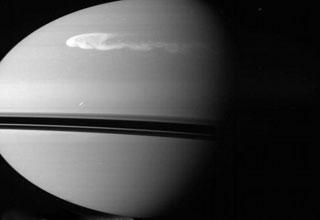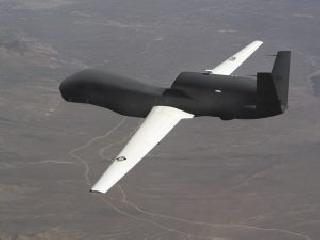
A storm, made up of frozen water and ammonia rolls across the surface of Saturn in this image captured by Cassini on December 24, 2010. Photo: NASA
LONDON (PTI): A massive storm, which could be one of the rare Great White Spot (GWS) outbreaks, has hit Saturn's northern hemisphere where the central squall measures half the size of Earth.
While the main spot is about 3,600 miles across the whole system including the tail streaming off to the right is more than 36,000 miles long, according to an image captured by NASA's Cassini Spacecraft.
The raw, unprocessed image was taken by Cassini on December 24 and received on Earth on December 27. It was taken from around one million miles away using a green filter and also shows the dark shadows of the planet's rings on the disk.
Scientists believe the spot appears white because it is made of ammonia ice crystals, the 'Daily Mail' reported.
Storms shoot warm gas up from Saturn's lower atmosphere and through a thick upper mantle of old, smog-stained ammonia ice. As the gas expands in the upper atmosphere, fresh crystals of ammonia condense on the cooling vapour, forming the white region visible from Earth.
Bridget Hesman, an assistant research scientist at the University of Maryland, said: "A balloonist floating about 100 kilometres down from the bottom of Saturn's calm stratosphere would experience an ammonia-ice blizzard."
The phenomenon - which is a lesser known equivalent of Jupiter's giant red spot - was first picked up by amateur astronomers in mid December.
When the bright white storm emerged on Saturn's northern hemisphere space enthusiast Anthony Wesley from Australia captured some early images of it.
"This is the brightest Saturn storm in decades," Anthony said, adding that "if you get a chance to see it visually then take it, as it may be one of the rare Great White Spot outbreaks on Saturn."
Great White Spots occur periodically on Saturn and are thought to be created by thermal instability on the planet.
They are usually large enough to be visible by telescope from Earth, the report said.
It is not yet known if this storm will develop into a classic GWS - if it does, it will have developed early.
The storms flare up every 28.5 years or so, previously showing up in 1876, 1903, 1933, 1960, and 1990. This corresponds with Saturn's orbital period around the Sun, the report said, adding that one should not be expecting another appearance until around 2018.
However, storms can show up at times that don't fit the cycle including one in 1994 and another in 2006. The picture is just the latest of hundreds taken by the Cassini spacecraft, which was launched by NASA in 1997. It reached Saturn in 2004.
 Previous Article
Previous Article Next Article
Next Article












The Indian Air Force, in its flight trials evaluation report submitted before the Defence Ministry l..
view articleAn insight into the Medium Multi-Role Combat Aircraft competition...
view articleSky enthusiasts can now spot the International Space Station (ISS) commanded by Indian-American astr..
view article